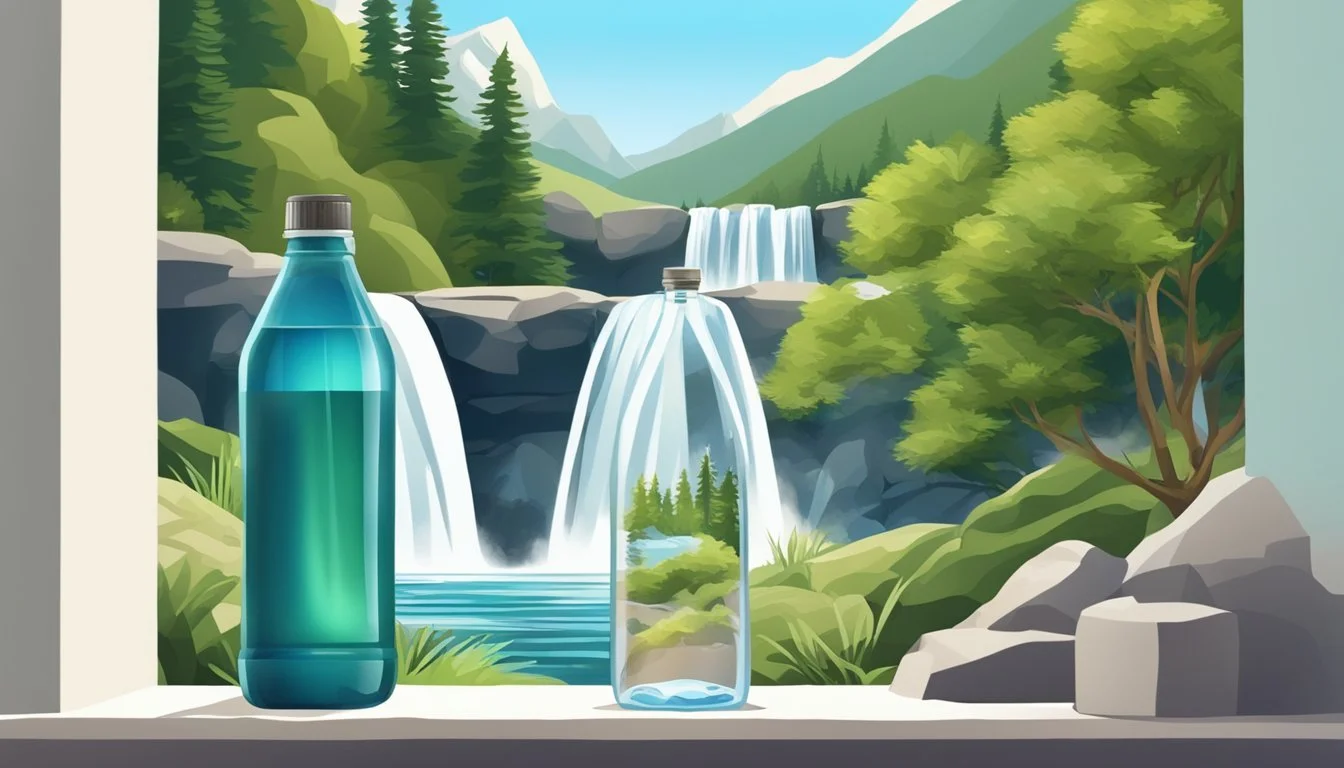Cascade Mountain vs. Open Water
A Comparative Evaluation
Choosing the right bottled water can feel like a daunting task with so many options available. Cascade Mountain and Open Water are two brands that often come up in discussions. Between the two, Cascade Mountain stands out for its well-balanced mineral content and natural spring source, making it a preferred choice for many health-conscious consumers.
Open Water offers a sleek design and a commitment to eco-friendly packaging, appealing to those who prioritize sustainability. Cascade Mountain, sourced from pristine springs, boasts a clean and crisp taste due to its natural filtration process. This makes it highly appealing for its purity and refreshing quality.
Both brands have their merits, with Cascade Mountain excelling in taste and mineral balance while Open Water leads in environmentally-friendly practices. The choice ultimately comes down to personal preference and individual priorities, whether they lie in flavor, health benefits, or sustainability.
Understanding Bottled Water
Bottled water comes in various types, each with unique characteristics, health implications, and environmental impacts. Knowing these aspects can help make an informed choice between Cascade Mountain and Open Water.
Types of Bottled Water
Spring Water: Derived from underground formations, spring water flows naturally to the earth's surface. Brands like Cascade Mountain Spring Water source their product from pristine natural springs, offering a pure and untouched experience.
Mineral Water: This type contains minerals naturally present at the source. It is often appreciated for its taste and potential health benefits.
Municipal Water: Sometimes bottled water comes from a municipal source but undergoes additional purification processes. This type is usually less expensive.
Alkaline Water: Known for its higher pH level, alkaline water is believed by some to provide health benefits from balancing the body's acidity.
Health Implications of Bottled Water
Bottled water is often marketed for its purity and taste, but health considerations vary by type.
Spring Water: Typically free of contaminants but should be certified by relevant health authorities. Brands like Cascade Mountain highlight their strict quality controls.
Mineral Water: Contains beneficial minerals such as calcium and magnesium. Overconsumption should be monitored to avoid mineral imbalances.
Municipal Water: Undergoes purification to remove contaminants, but is essentially the same as tap water. It’s a suitable option for those looking for purified water on the go.
Alkaline Water: Advocates claim it neutralizes acidity in the body, yet scientific backing is limited. Always consult with health professionals before significant dietary changes.
Environmental Impact of Water Bottling
The ecological footprint of bottled water includes energy use, water resource depletion, and plastic waste.
Sustainability: Cascade Mountain Spring Water uses eco-friendly glass bottles, reducing plastic pollution.
Resource Use: Extracting water from natural sources can impact local ecosystems. Responsible bottling practices are crucial.
Plastic Waste: The majority of bottled water sold in plastic contributes significantly to environmental pollution. Opting for brands using reusable packaging can mitigate this impact.
By considering these factors, consumers can make choices that align with their health needs and environmental values.
Origin and Source
Cascade Mountain and Open Water have distinct sources that define their unique qualities. They both prioritize purity but achieve it through different means.
Cascade Mountain: A Natural Wonder
Cascade Mountain Spring Water originates from a pristine, replenished spring in Oregon. The water is sourced from deep within the mountain's untouched wilderness, ensuring minimal exposure to pollutants.
This source is known for its ph-balanced profile.
The purity of Cascade Mountain water is maintained by bottling it in eco-friendly glass containers.
Drawing from these natural springs since 1911, Cascade Mountain has built a reputation for quality. The geographical region not only provides a unique taste but also supports the local ecosystem.
Open Water: The Concept of Sourced Purity
Open Water follows a different approach, focusing on reducing carbon footprint. The water is sourced from underground aquifers, ensuring a consistent quality and taste.
Open Water prioritizes sustainability by using recyclable aluminum packaging.
Its commitment to preserving source purity extends to their partnerships with facilities that aim to minimize environmental impact.
In addition to sourcing practices, Open Water often undergoes rigorous testing to maintain high standards. These practices reflect a balance between environmental responsibility and delivering pure, clean water.
Water Quality and Composition
When comparing Cascade Mountain and Open Water, understanding the specific qualities and compositions of each brand is crucial. This section discusses the mineral content, pH levels, and safety standards of both bottled waters to provide a clear comparison.
Analyzing Mineral Content
The mineral content of bottled water is essential for its taste and health benefits. Cascade Mountain is known for its rich mineral composition, including higher calcium content, which is beneficial for bone health. Open Water offers a more moderate mineral presence, focusing on balanced levels of essential minerals.
Here's a quick comparison table:
Mineral Cascade Mountain Open Water Calcium (mg/L) 45 30 Magnesium (mg/L) 10 8 Sodium (mg/L) 5 10
The distinct mineral profiles impact not only health benefits but also the overall drinking experience.
PH Levels and Balanced Water
Balanced pH levels in drinking water are crucial for maintaining health and ensuring the water is neither too acidic nor too alkaline. Cascade Mountain maintains a slightly alkaline pH of 7.8, which can aid in neutralizing body acidity and promote hydration.
Open Water tends to have a pH level closer to the neutral range, around 7.2. This offers a well-balanced drinking experience, suitable for daily consumption without significantly altering the body's pH level.
A stable and balanced pH contributes to the overall quality and appeal of the water.
Safety Standards and Quality Reports
Both brands adhere to strict safety standards and are subject to regular testing. Cascade Mountain complies with the Environmental Protection Agency (EPA) guidelines and provides detailed quality reports ensuring no contaminants exceed safe drinking water limits.
Open Water also meets EPA standards and is committed to transparency, offering accessible quality reports that confirm the safety and purity of their water. Their reports consistently show low levels of harmful chemicals, ensuring that both brands prioritize consumer health.
These commitments to safety and transparency build trust and verify the quality of the water you consume.
Comparison of Cascade Mountain and Open Water Brands
Cascade Mountain and Open Water offer distinct experiences in terms of taste, branding, pricing, and availability. This comparison will help to highlight key aspects for consumers considering either brand.
Taste Profile and Consumer Perception
Cascade Mountain boasts a pure, crisp taste that draws from pristine mountain springs. Consumers often describe it as refreshingly clean, with a natural sweetness.
Open Water, sourced from various springs, offers a lighter taste with a touch of mineral undertone. Consumer feedback indicates that the subtle minerality is appreciated by many, though it is noted to be less pronounced than Cascade Mountain.
Cascade Mountain:
Pure, crisp taste
Natural sweetness
Open Water:
Light taste
Subtle minerality
Branding and Market Trends
Cascade Mountain focuses on its natural origins, emphasizing purity and sustainability. Their branding often highlights a connection to nature, which appeals to eco-conscious consumers.
Open Water positions itself on convenience and modernity. The brand’s sleek packaging and recyclable materials cater to an audience that values environmental responsibility along with a contemporary aesthetic. Market trends show a growing preference for products that combine these elements.
Cascade Mountain:
Emphasis on purity and nature
Appeals to eco-conscious consumers
Open Water:
Focus on convenience and modern design
Eco-friendly materials
Price Affordability and Value
Price is a crucial consideration for many consumers. Cascade Mountain often carries a higher price tag due to its sourcing and packaging costs.
Open Water tends to be more affordable, making it accessible to a broader audience. The value proposition includes not only the lower price but also the environmental benefits from their fully recyclable packaging. This balance of cost and eco-friendliness can be a significant deciding factor.
Cascade Mountain:
Higher price
Premium sourcing and packaging
Open Water:
More affordable
Focus on value and sustainability
Availability and Convenience
Cascade Mountain is widely available in major grocery stores and specialty outlets. The brand's reach ensures that it is accessible to consumers across different regions.
Open Water prioritizes convenience with a strong presence in convenience stores, online retailers, and various vending machines. This wide distribution network makes it highly convenient for on-the-go consumption.
Cascade Mountain:
Available in grocery stores and specialty outlets
Wide regional accessibility
Open Water:
Strong presence in convenience stores and online retailers
Easy access for on-the-go consumption
Filtration and Purification Processes
The production of Cascade Mountain and Open Water involves advanced methods to ensure water quality and safety. These processes include reverse osmosis and various filtration techniques, alongside sterilization measures to eliminate contaminants.
Understanding Reverse Osmosis
Reverse osmosis is a crucial method in water purification. This process employs a semi-permeable membrane to filter out contaminants. Water molecules pass through the membrane, leaving behind impurities like lead, chemicals, and various microorganisms.
This method ensures a high purity level. For both Cascade Mountain and Open Water, reverse osmosis plays a central role. It removes up to 99% of dissolved solids, making the water significantly safer and cleaner for consumption.
The Role of Filtration in Water Quality
Filtration is another essential aspect of maintaining water quality. Various water filters target different contaminants. Carbon filters, for instance, are effective in eliminating chlorine and organic compounds that affect taste and odor.
Cascade Mountain and Open Water use multi-stage filtration systems. These systems often combine mechanical, chemical, and biological filters. This multi-layered approach ensures comprehensive removal of contaminants, enhancing water taste and safety.
Sterilization Measures for Safety
Sterilization ensures that water is free from harmful bacteria, viruses, and other microorganisms. Methods such as ultraviolet (UV) light, ozonation, and chlorination are commonly used.
Cascade Mountain uses UV light for sterilization, an effective method that inactivates microorganisms without adding chemicals. Open Water also employs UV sterilization, ensuring the bottled water is safe for drinking by destroying pathogens that might have evaded other filtration processes.
Both brands prioritize these sterilization techniques to prevent any health risks associated with microbial contamination. This comprehensive approach ensures that the final product is as safe and clean as possible for consumers.
Health and Hydration
Assessing bottled water for health benefits requires examining hydration and the essential minerals it may provide, such as calcium, sodium, magnesium, and potassium.
Hydration and Its Significance
Hydration is crucial for maintaining bodily functions such as temperature regulation, joint lubrication, and nutrient transport.
Cascade Mountain and Open Water both offer efficient hydration, though the choice may affect individual health needs.
Children, because of their higher water needs relative to body weight, might require more frequent hydration. Different waters, based on mineral content, can offer varying levels of hydration efficiency.
Cascade Mountain water’s potential benefits lie in its mountain source, suggesting a purer form.
Meanwhile, Open Water’s packaging promotes sustainability, appealing to environmentally conscious consumers without compromising hydration quality.
The Connection Between Minerals and Health
Essential minerals like calcium, sodium, magnesium, and potassium play significant roles in bodily functions.
Mineral content in water can contribute to daily intake. For instance, calcium supports bone health, which is critical for children and adults alike.
Sodium, while often limited, is vital for nerve function and fluid balance.
Magnesium aids in muscle and nerve function, and potassium helps regulate heart and muscle contractions.
Cascade Mountain may offer a broader mineral profile due to its natural source.
Open Water's minimalist approach may lack the diverse minerals some prefer.
Knowing the mineral content helps consumers choose water that aligns with their dietary needs.
Environmental and Social Responsibility
The impact of bottled water on the environment and society involves several factors, including the materials used in packaging and corporate sustainability practices.
Assessing Ecological Footprints
Bottled water's ecological footprint largely depends on the packaging material. Glass bottles, although more luxury-oriented, have a higher production footprint compared to plastic bottles. However, glass is fully recyclable and generally preferred for its inert properties.
Plastic bottles, particularly those made from PET, are lightweight and cost-effective but pose significant waste management issues. Though PET is recyclable, a large volume of these bottles end up in landfills due to inefficient recycling processes. Organizations like the Environmental Working Group advocate for increased use of recycled materials to mitigate environmental impact. Reusable bottles also offer a sustainable alternative, significantly reducing single-use plastic waste.
Promoting Sustainability in Water Brands
Water brands are increasingly promoting sustainability through various initiatives. For instance, Cascade Mountain Spring Water uses eco-friendly glass containers and sources its water from a naturally replenished spring, emphasizing its commitment to environmental protection. Such efforts aim to minimize their ecological footprint.
In contrast, larger companies like Nestlé Waters North America focus on the recyclability of their PET bottles and aim to increase the amount of recycled PET in their products. This approach helps to close the loop on plastic waste.
Municipal water sources used by some brands are also regulated by the Environmental Protection Agency, ensuring safety and sustainability. Boxed water and similar innovations are emerging, offering more eco-friendly packaging options.
The rise of family-owned brands underscores a commitment to socially responsible practices, aligning closely with community values and environmental stewardship.
Packaging and Storage
When it comes to bottled water, the packaging material and storage considerations play crucial roles in determining the environmental impact and user experience. Understanding the differences between glass and plastic bottles, as well as the shift toward reusable and eco-friendly solutions, is essential.
Glass vs. Plastic: A Matter of Choice
Glass bottles are praised for their purity and the absence of chemicals that can leach into the water. They provide a premium feel and are often recyclable multiple times without degradation in quality. Consumers who prioritize taste and environmental sustainability often prefer glass, despite its heavier weight.
Plastic bottles, typically made from PET (Polyethylene Terephthalate), are lighter and more convenient for on-the-go hydration. PET bottles are recyclable, but the recycling rate is lower compared to glass, and the plastic can degrade over time. Concerns about BPA and other chemicals leaching into the water have spurred debates about the safety of plastic bottles.
The Shift to Reusable and Eco-Friendly Solutions
The rise of reusable bottles has marked a significant trend toward sustainability. Materials like stainless steel and BPA-free plastic are popular choices for their durability and safety. These bottles reduce single-use plastic waste and offer better insulation properties to keep beverages at the desired temperature.
Boxed Water and similar brands use cartons made predominantly of sustainable paper, combined with aluminum and plastic to ensure water resistance and sealing. These alternatives boast a higher percentage of renewable materials compared to traditional plastic bottles, reflecting an ongoing shift towards more environmentally conscious packaging solutions.
By selecting packaging that aligns with personal values and lifestyle preferences, consumers can make informed decisions that benefit their health and the environment.
Innovation and Future Trends
In the evolving bottled water industry, brands are increasingly investing in new technologies and premium experiences to stand out. These innovations range from advanced water filtration systems to the rise of water sommeliers enhancing the drinking experience.
Emerging Water Technologies
Companies like Mitte and Brita are leading the way in water purification technology. Mitte, for example, offers a smart home water system that not only filters but also enhances water with essential minerals. This approach delivers a more balanced pH and improved taste.
Brita, known for its pitcher filters, continuously improves its filtration technology to remove more contaminants. Newer models focus on reducing microplastics, something increasingly important to health-conscious consumers.
Additionally, the use of eco-friendly materials for bottling, such as biodegradable and recyclable packaging, reflects a significant trend. Brands are prioritizing sustainability, complementing their technological advancements. Research and development in this area promise further innovations, aiming to provide purer, safer, and more delicious water.
The Rise of Water Sommeliers and Premium Experiences
The emergence of water sommeliers is transforming the way consumers perceive and enjoy bottled water. These experts guide individuals through tasting sessions, highlighting subtle flavor profiles and textures previously unnoticed.
Premium experiences in water drinking are growing, with consumers willing to pay more for superior quality. High-end bottled water brands are packaging their products in elegant, eco-friendly bottles. Cascade Mountain, for instance, prides itself on its pristine, pH-balanced water presented in stylish glass containers.
Studies have shown that the presentation and perceived quality of bottled water can significantly influence consumer satisfaction. As this trend grows, expect more brands to offer exclusive experiences designed to elevate the everyday act of drinking water into a refined enjoyment.







